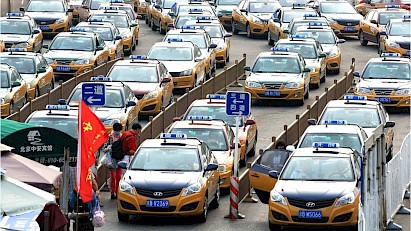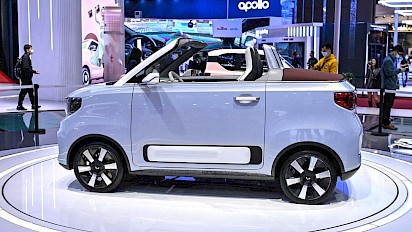China's electric car market is booming but can it last?
 If you want to understand how governments can fuel the rise of new technologies, look no further than the taxi fleets of Beijing.
If you want to understand how governments can fuel the rise of new technologies, look no further than the taxi fleets of Beijing.
Five years ago, the city revealed plans to ban the introduction of fossil fuel-powered taxis. Today, thousands of the cars run on batteries instead. And the drivers of these electric vehicles (EVs) don’t have to worry about wasting time at charging stations, either.
Many electric taxis in Beijing, and dozens of other Chinese cities, just go to a battery-swapping station where a machine plucks out the depleted battery and installs a charged one in mere minutes.
“They want to drive out there and earn some money so they definitely don’t want to wait two hours for EV charging,” explains I-Yun Lisa Hsieh from National Taiwan University.
This is just one facet of the increasingly diverse and booming market for electric cars in China. Members of the public are also snapping up EVs in unprecedented numbers.
In July, the China Passenger Car Association predicted that 6 million new EVs would be registered in the country in 2022 - a revision of its previous forecast of 5.5 million EVs to be sold this year.
Tesla had its best ever month in China in September, according to its most recent figures, selling 83,135 cars.
Nearly a quarter of all cars newly registered in China are now electric or plug-in hybrid vehicles, meaning that the country is ahead of Europe and well ahead of the US in adoption of these technologies. Half the world’s EVs are sold in China.
And this is largely driven by government mandates and incentives, says Mr Hsieh. For more than a decade, the Chinese government has subsidised EV purchases. The value of these subsidies has fallen over time, and they are due to end by 2023, but there are still plenty of reasons why buying an electric car is a financial no-brainer.
Many buyers of new fossil fuel vehicles in China have to pay out, not only for the car, but the licence plate as well. “It’s really expensive,” says Mr Hsieh. A new licence plate in Shanghai costs nearly 100,000 yuan (£12,500; $14,000).
There are other perks if you opt for an EV instead, though they differ from city to city. In Liuzhou, authorities have allowed EV owners to drive in bus lanes. And they get access to free parking spaces as well.
Then there is the potentially irresistible price tag of some vehicles. The Wuling Hong Guang Mini EV bucks the trend of EVs being a relatively expensive option.
 The entry-level version of this dinky, no-frills car costs the equivalent of just £4,200 and appeals to city-dwellers and first-time car owners, says Jon Hykawy, president and director of Stormcrow Capital, a consulting and research firm.
The entry-level version of this dinky, no-frills car costs the equivalent of just £4,200 and appeals to city-dwellers and first-time car owners, says Jon Hykawy, president and director of Stormcrow Capital, a consulting and research firm.
“These are vehicles that could be sold through a big chunk of Asia as well,” he adds.
The Hong Guang Mini is currently China’s most popular EV. But there are a host of options at the other end of the price scale, such as Tesla’s Model Y (£49,000) or Xpeng’s P7 (£30,410). Both are in the list of top 10 best-selling EVs in China.
The Chinese EV market is enormously competitive and lots of companies are vying for a place in it. Even an airline, Juneyao, wants to start making electric cars, according to a recent report from the Reuters news agency.
“It’s a very good environment for these manufacturers to develop technology,” says Pedro Pacheco, an analyst at Gartner, noting that the range offered by some battery EVs in China is particularly good.
And manufacturers are filling higher-end EVs with infotainment systems and other gadgetry in a further attempt to woo consumers.
But two big questions hover over the frenzy for electric cars in China. Firstly, will it last? And secondly, how will it shape the global EV market?
Ana Nicholls, director of industry analysis at the Economist Intelligence Unit, says she has been surprised at just how quickly EVs have flown out of dealerships in China lately but argues that, with the removal of subsidies for purchasers of new vehicles, the appetite for EVs could wane.
“It’s hard to see how the EV market can carry on expanding at quite this rate in the future,” she says.
Charging infrastructure remains unevenly distributed and subject to supply issues - some charging stations were curtailed recently thanks to a fall in electricity production caused by the mega drought affecting parts of China.
Usually, more EV owners means rising demand for electricity in general and China faces an uphill battle in supplying all of these new vehicles at the same time as the country is trying to cut coal consumption at its power plants.
This is one reason why some analysts, including Mr Hykawy, argue that hybrid electric vehicles are a better option than cars that run on batteries alone, since they will be less reliant on the grid.
They also require less lithium, given their smaller batteries, which could be important given potential shortages of lithium expected in the coming years.
As for how the Chinese EV market could influence the rest of the world, the jury is still out. But it is already starting, with Chinese firms marketing EVs in Latin America, Africa and elsewhere. High-end manufacturer Nio is also bringing its battery-swapping stations to Norway and has just opened its second such station in the country.
Mr Pacheco argues that more major car brands would have to adopt battery swapping for the technology to become widespread in Europe. But he highlights the success of ultra low-cost EVs in China - such as the vehicles offered by local brands Wuling and Chery.
“In China, they already have affordable EVs,” he says. “In Europe, we’re not there yet.”
In emerging markets, these are exactly the kind of vehicles that could catch on. Time to conquer the world? Maybe. But there’s another school of thought that says, well, the world can wait.
“As long as the Chinese market is booming, they may as well just sell locally,” says Ms Nicholls. “I mean, why wouldn’t you?”
Analysts tend to agree that it will be very interesting to see what happens when the subsidies run out. That could push Chinese EV makers towards other markets - and maybe we’ll all fall in love with EVs thanks, indirectly, to the policies of Chinese authorities. We’ll have to wait and see.
You can return to the main Market News page, or press the Back button on your browser.

